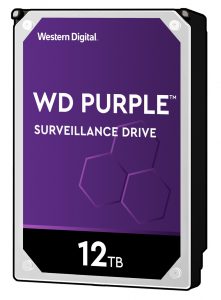![]()
Decisions, decisions. Every day we must make hundreds, if not thousands, of decisions in our daily personal and professional lives. Whether it’s what to wear, how to eat healthy for lunch or go for the cheeseburger and fries combo meal…or big things like how we can make our world better. So I’ll make one decision easier by sharing how to choose the right surveillance-optimized drive for your surveillance systems.
What does it mean to be surveillance-optimized? To start it means the drive has been designed and tested specifically for the needs of the surveillance industry, which are very different than drives created for desktop use. Let me explain with these 5 things to consider when choosing a drive to support your round-the-clock surveillance needs:
- Firmware Optimizations – A Drive That Understands the Workload
Desktop drives are primarily optimized around well-known operating systems and associated business and consumer applications. Typically, these types of PC applications have a balanced read / write ratio to the hard drive. This enables a more generic firmware cache policy to support this more balanced reading and writing within the PC system.
Surveillance is a very different type of workload. In surveillance, the ultimate goal is capture what’s happening, at all times, so you don’t miss an important event. However, much of the surveillance footage captured is not reviewed; only in the case of an incident. Thus, surveillance drives are optimized to prioritize write cycles of video being recorded by the surveillance cameras over the playback, or read cycles, of the recorded video, as there is a much higher balance of writing than reading to the hard drive . The optimizations enable the hard drive to have high bandwidth for high quality recording of video. In addition, the surveillance hard drive is also optimized for both software and hardware RAID to deliver high performance in multi-drive configurations.
- Compatibility with Surveillance Systems
Surveillance hard drives are tested for compatibility and functionality in purpose-built surveillance systems in collaboration with leading surveillance system manufacturers. This testing and approval help provide high confidence that your surveillance system and storage will provide reliable operation for your surveillance needs.
Desktop drives are tested for compatibility and functionality in PCs as that is their intended use case. Due to the fact that these drives are not optimized for surveillance systems there is generally no compatibility testing performed with leading surveillance system manufacturers as the desktop drives are not specifically designed for this type of application.
- Annual Power on Hours – A Drive Built for systems that Record 24×7
Surveillance optimized drives are designed for systems that are always on recording 24 x 7 x 365. This is not a trivial attribute. For example, we perform more stringent reliability testing on each of our WD Purple™ hard drives to make sure that they are up to the task of operating in a surveillance system that is always on for recording.
Desktop hard drives are designed around 8 hours daily use in a desktop PC which is not aligned with the typical use case for surveillance systems. Depending on the surveillance system configuration, the cameras may be set up to record 24×7 which would cause the desktop drive to operate longer than for what it was designed.
- Annualized Workload Rate – Get the Right ‘Workhorse’
Annualized Workload Rate is the amount of data transferred to and from the hard drive divided by the current Power on Hours.
Surveillance optimized drives are typically designed to support around 180 terabytes per year workload rate due to the potential of a high number of cameras (up to 64 cameras per hard drive) sending video data to the surveillance system, and you’ll find that higher capacity models may have even higher ratings. The 180 terabytes per year workload rate equates to around 500 gigabytes of recording per day assuming 24 x 7 operation.
Desktop drives are typically designed for only around 55 terabytes per year workload, which equates to around 150 gigabytes of data transfer per day. Thus, between the two, surveillance drives are specifically designed to handle the demanding workloads of surveillance systems.
- Vibration Compensation to Ensure Drive Head Stays on Track
In larger multi-drive surveillance systems, drive to drive vibration, as well as vibration from the system fans can cause drives used in surveillance systems to have recording performance challenges. This is due to the fact that it’s very difficult for the hard drive to operate and stay on the very narrow tracks that the data is being recorded onto within the drive. If the vibration becomes too high it can cause the drive to stop writing so that data already written to the media will not be accidentally overwritten. This can cause lapses in the video that may not be recorded. This loss of recordings limits the amount of video that can be played back.
Western Digital surveillance optimized drives, with capacities of 4TB and greater, have enablers to help compensate for the vibration being imparted on the drive that allow the drive to stay on track and continue to write the video recording with high throughput. The enablers that help with this compensation are typically hardware and software features that are not supported or required on desktop class hard drives.

Western Digital’s WD Purple Family of Surveillance-Optimized Drives
The above major features and specifications of our WD Purple drive are the result of working closely with leading surveillance system manufacturers as well as analyzing the various types of surveillance systems being shipped in the market place. With a wide range of industry-leading enclosures and chipsets supported, you’re sure to find the configuration and compatibility that’s right for your analog or network video recorder.
Furthermore, our embedded devices, cards, HDDs and platforms for surveillance systems all live under one brand. You can be assured with consistency of products, support and service all in one place.

Article by: Darrin Bulik
Darrin Bulik, the product marketing director of Western Digital. In January 2014, Darrin entered to the Increased challenge with international leadership In the product marketing department by focus on desktops NAS, security systems, video and hard disk drive products in digital format. He has more than 24 years of experience in the storage industry.
